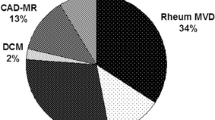Abstract
Background
We assessed whether the simultaneous sequential strategy could (1) achieve additional sinus restoration for those patients who were not in sinus rhythm while coming off bypass after modified left maze procedure and (2) attain the same long-term success rates as the bi-atrial maze procedure in patients with persistent atrial fibrillation (AF) and mitral valve disease.
Materials and Methods
Twenty-seven consecutive patients – ten men and 17 women with a mean age of 52 ± 13 years, all with persistent AF and mitral valve disease – underwent the modified maze procedure with the simultaneous sequential strategy. In the first phase, the modified left atrial maze operation was carried out with concomitant valvular surgery; the right side maze operation was subsequently carried out as a second phase of the sequential strategy only if AF re-appeared following the spontaneous restoration of heart beats during the operation.
Results
Twenty patients (74.1%) underwent the left atrial maze procedure only, and seven patients (25.9%) required the subsequent right atrial maze procedure as part of the sequential strategy. At a mean follow-up of 15.1 ± 7.7 months, six of the 27 patients (22.2%) who underwent additional right atrial maze procedure had restored sinus rhythm. At a mean follow-up of 17.8 ± 7.3 months, 24 of the 27 patients (88.9%) had restored sinus rhythm and 22 patients (81.5%) had restored bi-atrial transport function (right atrial filling fraction: 40.8 ± 11.7%; left atrial filling fraction: 22.9 ± 8.1%) after application of the sequential strategy.
Conclusions
Compared with modified left atrial maze procedure, the application of the simultaneous sequential strategy successfully restored sinus rhythm in an additional 22.2% of patients with persistent AF. The overall sinus conversion rate of 88.9% was comparable with that of the standard bi-atrial maze procedure.


Similar content being viewed by others

Abbreviations
- AF:
-
atrial fibrillation
- RF:
-
radiofrequency
References
Chesebro JH, Fuster V, Halperin JL. Atrial fibrillation – risk marker for stroke. N Engl J Med 1990;323:1556–1558
Benjamin EJ, Wolf PA, D’Agostino RB, et al. Impact of atrial fibrillation on the risk of death: the Framingham heart study. Circulation 1998;98:946–952
Cox JL, Boineau JP, Schuessler RB, et al. Successful surgical treatment of atrial fibrillation: review and clinical update. JAMA 1991;266:1976–1980
Cox JL, Boineau JP, Schuessler RB, et al. Modification of the maze procedure for atrial flutter and atrial fibrillation. I. Rationale and surgical results. J Thorac Cardiovasc Surg 1995;110:473–484
Cox JL, Jaquiss RDB, Schuessler RB, et al. Modification of the maze procedure for atrial flutter and atrial fibrillation: II. surgical technique of the maze III procedure. J Thorac Cardiovasc Surg 1995;110:485–495
Kosakai Y, Kawaguchi AT, Isobe F, et al. Modified maze procedure for patients with atrial fibrillation undergoing simultaneous open heart surgery. Circulation 1995;92 [Suppl 2]:359–364
Imai K, Sueda T, Orihashi K, et al. Clinical analysis of results of a simple left atrial procedure for chronic atrial fibrillation. Ann Thorac Surg 2001;71:577–581
Chen MC, Chang JP, Guo GB, et al. Atrial size reduction as a predictor of the success of radiofrequency maze procedure for chronic atrial fibrillation in patients undergoing concomitant valvular surgery. J Cardiovasc Electrophysiol 2001;12:867–874
Chen MC, Chang JP, Chang HW. Preoperative atrial size predicts the success of radiofrequency maze procedure for permanent atrial fibrillation in patients undergoing concomitant valvular surgery. Chest 2004;125:2129–2134
Sie HT, Beukema WP, Elvan A, et al. Long-term results of irrigated radiofrequency modified maze procedure in 200 patients with concomitant cardiac surgery: six years experience. Ann Thorac Surg 2004;77:512–516
Sie HT, Beukema WP, Ramdat Misier AR, et al. Radiofrequency modified maze in patients with atrial fibrillation undergoing concomitant cardiac surgery. J Thorac Cardiovasc Surg 2001;122:249–256
Wyse DG, Waldo AL, DiMacro JP, et al. A comparison of rate control and rhythm control in patients with atrial fibrillation. N Engl J Med 2002;347:1825–1833
Van Gelder IC, Hagens VE, Bosker HA, et al. A comparison of rate control and rhythm control in patients with recurrent persistent atrial fibrillation. N Engl J Med 2002;347:1834–1840
Boineau JP, Canavan TE, Schuessler RB, et al. Demonstration of a widely distributed pacemaker complex in the human heart. Circulation 1988;77:1221–1237
Chen MC, Chang JP, Chen CJ, et al. Atrial pacemaker complex preserved radiofrequency maze procedure reducing the incidence of sick sinus syndrome in patient with atrial fibrillation. Chest 2005;128:2571–2575
Feinberg MS, Waggoner AD, Kater KM, et al. Restoration of atrial function after the maze procedure for patients with atrial fibrillation: assessment by Doppler echocardiography. Circulation 1994;90:285–292
Yuda S, Nakatani S, Isobe F, et al. Comparative efficacy of the maze procedure for restoration of atrial contraction in patients with and without giant left atrium associated with mitral valve disease. J Am Coll Cardiol 1998;31:1097–1102
Usui A, Inden Y, Mizutani S, et al. Repetitive atrial flutter as a complication of the left-sided simple maze procedure. Ann Thorac Surg 2002;73:1457–1459
Golovchiner G, Mazur A, Kogan A, et al. Atrial flutter after surgical radiofrequency ablation of the left atrium for atrial fibrillation. Ann Thorac Surg 2005;79:108–112
Deneke T, Khargi K, Grewe PH, et al. Left atrial versus bi-atrial maze operation using intraoperatively cooled-tip radiofrequency ablation in patients undergoing open-heart surgery: safety and efficacy. J Am Coll Cardiol 2002;39:1644–1650
Morady F. Catheter ablation of supraventricular arrhythmias: state of the art. J Cardiovasc Electrophysiol 2004;15:124–139
Cappato R, Negroni S, Pecora D, et al. Prospective assessment of late conduction recurrence across radiofrequency lesions producing electrical disconnection at the pulmonary vein ostium in patients with atrial fibrillation. Circulation 2003;108:1599–1604
Author information
Authors and Affiliations
Corresponding author
Rights and permissions
About this article
Cite this article
Chang, JP., Chen, MC., Kao, CL. et al. Role of the Simultaneous Sequential Strategy for Failed Acute Sinus Restoration after Modified Left Maze Procedure for Persistent Atrial Fibrillation with Concomitant Mitral Surgery. World J. Surg. 30, 1802–1808 (2006). https://doi.org/10.1007/s00268-006-0382-0
Published:
Issue Date:
DOI: https://doi.org/10.1007/s00268-006-0382-0



